
Back Nuwewêreldse aasvoël Afrikaans نسور العالم الجديد Arabic نسور العالم الجديد ARZ Cathartidae AST Pukey (Cathartidae) AVK Амерыканскія грыфы Byelorussian Амэрыканскія грыфы BE-X-OLD Американски лешояди Bulgarian Cathartidae Breton Voltors del Nou Món Catalan
| New World vultures | |
|---|---|

| |
| Turkey vulture | |
| Scientific classification | |
| Domain: | Eukaryota |
| Kingdom: | Animalia |
| Phylum: | Chordata |
| Class: | Aves |
| Order: | Accipitriformes |
| Family: | Cathartidae Lafresnaye, 1839 |
| Genera | |

| |
| Approximate Cathartidae range map Summer-only range of turkey vulture At least one species present year-round
| |
| Synonyms | |
| |
Cathartidae, known commonly as New World vultures or condors, are a family of birds of prey consisting of seven extant species in five genera. It includes five extant vultures and two extant condors found in the Americas. They are known as "New World" vultures to distinguish them from Old World vultures, with which the Cathartidae does not form a single clade despite the two being similar in appearance and behavior as a result of convergent evolution.
Like other vultures, New World vultures are scavengers, having evolved to feed off of the carcasses of dead animals without any notable ill effects. Some species of New World vulture have a good sense of smell, whereas Old World vultures find carcasses exclusively by sight. Other adaptations shared by both Old and New World vultures include a bald head, devoid of feathers to prevent rotting matter from accumulating while feeding, and an extremely disease-resistant digestive system to protect against scavenging-related germs.